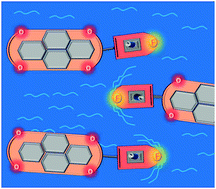Unraveling the unusual effect of fluorination on crystal packing in an organic semiconductor†
Abstract
Owing to combination of chemical and thermal stability, favorable molecular packing, and efficient electron transport, naphthalene diimide derivatives (NDIs) are promising materials for n-channel organic field effect transistors (OFETs). For tuning the properties of n-conductive organic semiconductors, as well as for improvement of their air stability, fluorination is a frequently used approach. In this study, we demonstrate how very small modification of the molecular structure – fluorine substitution in the p-position of the phenyl rings of N,N′-diphenyl-NDI (Ph-NDI) – dramatically changes the crystal packing but almost does not affect electron transport. We show that this two-atom modification of Ph-NDI changes the molecular packing motif from π-stacking to a herringbone one, in contrast with usually observed improvement of π-stacking with fluorination. This unexpected behavior is mainly attributed to changes in the electrostatic potential of the phenyl rings as a result of fluorination, which alters their relative orientation and modifies the packing of the NDI cores. Nevertheless, though the herringbone packing is typically considered as less favorable for charge transport, the theoretical electron mobility is slightly higher in the fluorinated Ph-NDI. The results obtained improve the understanding of the relationship between the molecular and crystal structures of organic semiconductors and their impact on charge transport, which is of key importance for rational design of high-mobility materials for organic electronics.



 Please wait while we load your content...
Please wait while we load your content...